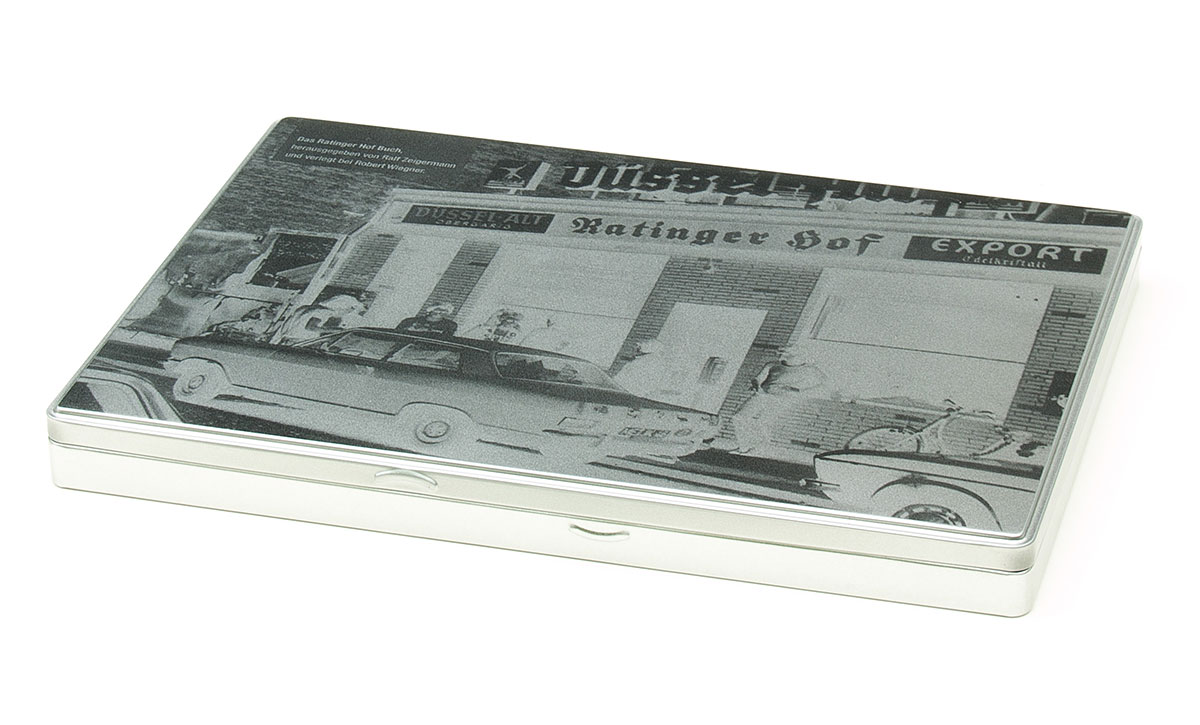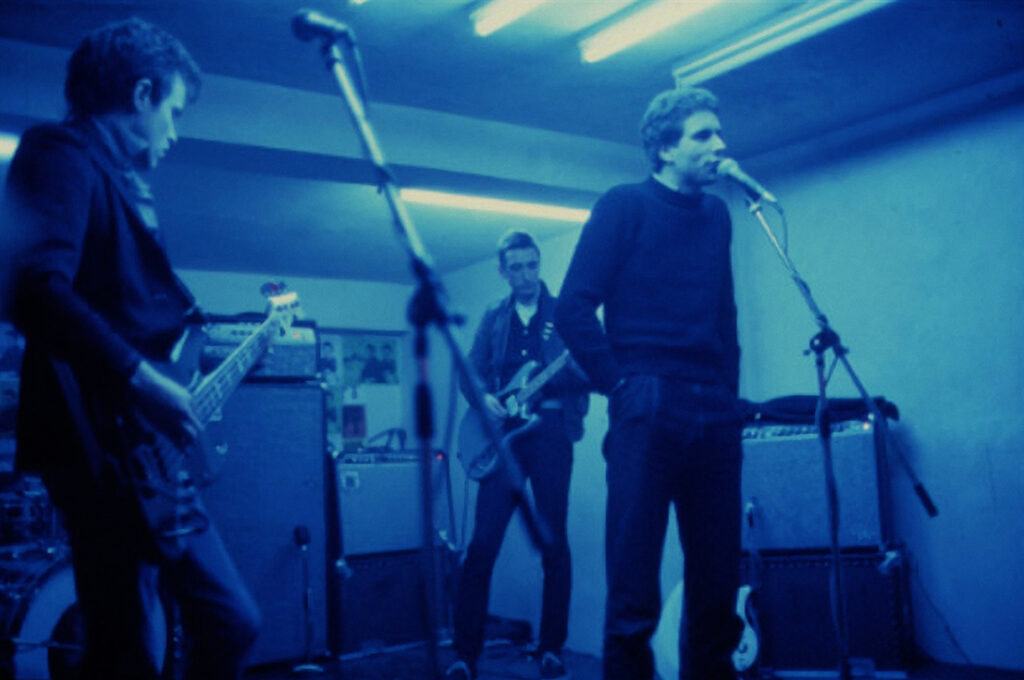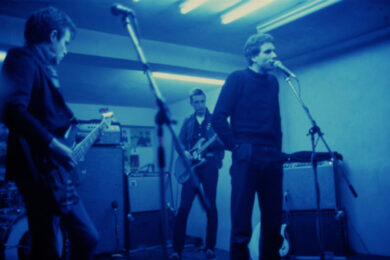Ralf Zeigerman has designed and edited a book about the years 1977 – 1985 at the Ratinger Hof, crammed with photos and articles by the people who were there when it all happened. The book is supplied in a printed tin box, and while the text is obviously in German, the recollections of Wire’s Colin Newman and Graham Lewis have been left in their original language. Of possible interest to any hardcore Wire fans might be the fact that included in the box is a faithful reproduction of the “Wire-Beermat-ticket”.
The Ratinger Hof was a pub located in Ratinger Straße, Düsseldorf. In the early seventies it used to be one of those typical dumps with old sofas, serving Altbier to gloomy and quite possibly half-naked, long-haired people who were more or less peacefully smoking illegal substances and listening to the latest records of Pink Floyd or the Rolling Stones.
This changed dramatically when Carmen Knoebel and Ingrid Kohlhöfer took over. Carmen, wife of the German avantgarde artist Imi Knoebel, quickly threw out the tattered old sofas and carpets, had the walls painted white and installed neons on the ceiling in the primary colours of red, blue and yellow, as well as rather useless mirrors on the walls, too high upon the walls to serve any purpose other than just being there. A small corner for people to dance, with a muted TV Set above them; a few snooker tables and 2 pinball machines. Welcome to the new Ratinger Hof.
Due to Carmen’s connection with the Düsseldorf art scene and the convenient location of the Ratinger Hof being just around the corner of the art academy, the local artists soon frequented the Ratinger Hof and became regulars there: Joseph Beuys, Sigmar Polke, Jörg Immendorff, Albert Oehlen (together with his brother Markus Oehlen), Martin Kippenberger, Blinky Palermo and many others.
This was already quite a change from the scruffy old Hippie-Pub (which, according to Wikipedia, once even served as a “Wild-West Club”) to a more modern artists’ outfit, but in late 1976 this changed even further: slowly but steadily punk rock crept into Germany.
Suddenly people showed up with cropped hair and they began to dress in plastic and leather rather than hand-knitted jumpers and listened to this very new music from the States and the UK. At first they just copied the style and the three-chord bars, but from early 1977 those fans developed their own style and music – and it all happened in Düsseldorf at the Ratinger Hof. It is probably best described as a new way of Kraut Rock, where Punk meets art. The crude chords of Mittagspause may serve as the best example here – just look them up on YouTube:
I believe nobody nowadays can remember why it all happened at Ratinger Hof, or why Ratinger Hof was so unique – after all, there was the SO36 club in Berlin and a few places in Hamburg – but neither of those managed this incredible interconnection of Punk meets Art.
Perhaps it was because Markus Oehlen was working as a DJ there, perhaps it was because Carmen allowed everything to happen there, perhaps it was because Janie, Mary-Lou, myself and others just used to meet up there and form bands. No – we can’t remember, because it just happened and it happened so incredibly quickly.
Janie is Peter Hein and the singer and writer of Fehlfarben; Mary Lou is Franz Bielmeier, who later set-up the ground-breaking Rondo record label and played guitar with Mittagspause, the predecessor of Fehlfarben. All of a sudden lots of bands were founded there and they all had their first gigs at Ratinger Hof: Charley’s Girls, Mittagspause, Fehlfarben, Male, Die Krupps, DAF, S.Y.P.H., Minus-Delta-T, die Toten Hosen – the list is almost endless.
In the beginning the stage was made up from a few snooker tables, pushed together and covered with a board, as the first band ever from abroad to play at the Ratinger Hof was soon to find out: Wire.
Wire, having just released their second album Chairs Missing, entered the so-called stage on 9.11.1978 and delivered an unforgettable performance, starting their set with “Practice makes perfect”. In true Ratinger Hof tradition, the ticket to the show was a stamped, handwritten and numbered beermat!
In the years to come, lots of bands followed, most of them with an “art” background: 999, Pere Ubu, Bauhaus … in fact, Pere Ubu played their first gig in Germany at Ratinger Hof.
Then, in the early 80s, when Punk was already dead, Carmen left the business to Ingrid and slowly the Ratinger Hof became history. But by then history was already written.
Colin Newman on Wire at the Ratinger Hof
"1978 was a watershed year for Wire, it was not only the year in which Chairs Missing, our second and arguably finest 70’s release was recorded and released, but also the first year in which we took our stark, minimalist, arty sound to concert stages beyond the UK.
"Not only did the band debut in New York that year but it also made a tour in November which took in venues in Belgium, The Netherlands and Germany.
"On that tour were three dates in Berlin at the infamous SO36 club (where the artist Martin Kippenberger famously crashed through the glass doors when one show was attacked by anarcho-punks) but more significantly one at the Ratinger Hof in Düsseldorf, at that point the nexus for all that was cool and prescient in the industrialised western part of Germany and at which Wire made the first ever performance by a British band.
"The difference between the two cities at the time being that while Berlin embraced the punk ethic because it fitted with the overall political nature of it’s street culture, the Düsseldorf scene was much more interested in art – and that was a direct influence of the club itself.
"The club, run by Carmen Knoebel and her partner Brigitta Rohrbach was the natural meeting place for those who were interested to look beyond the obvious punk influences and embrace the newer, cooler, artier European sound which has been retrospectively named ‘post punk’. Whether or not the club’s artsy ambience developed that way because of the pair’s natural affinity to a wider artist culture or for other reasons is a matter for debate. However they both remain part of the German arts scene to this day.
"Another influence at that time was broadcaster Alan Bangs whose niche show on the British Forces Radio located in nearby Köln provided generational fuel. He would often choose the club as his favourite hang out place. So it is hardly surprising that ‘the Hof’ gave birth to a strain of collaboration representing the more wilful and interesting end of the Neue Deutsche Welle scene. In particular projects such as Mittagspause, Fehlfarben, DAF and die Krupps stand as testament to what was created there. Wire only played at the Ratinger Hof the one time on 9th November 1978, however we returned for a social visit on the 13th February 1979 on the eve of recording the infamous Rockpalast show (itself at the invitation of then host Alan Bangs). It is easy to apply the rose-tinted goggles in hindsight but I remember very well the sense of a kind of homecoming felt on that occasion, not so much of being visiting ‘stars’ but of somehow being part of it.
"We were told by many that Wire was the key band for them and although we encountered that sense in certain parts of northern Britain there was simply nowhere else outside the UK where we had that feeling. At that point one could say that the Ratinger Hof was the one place, outside the UK, that Wire truly felt at home. So you could say that evening was something of a celebratory homecoming.
"Sharp observers of the interview which followed the Rockpalast performance will note the obvious hangovers from the night before!"
For more on the Ratinger Hof book, please visit Ralf’s website. Wire play the Lextington November 8th and 9th, their new album Red Barked Tree is released on January 10th




